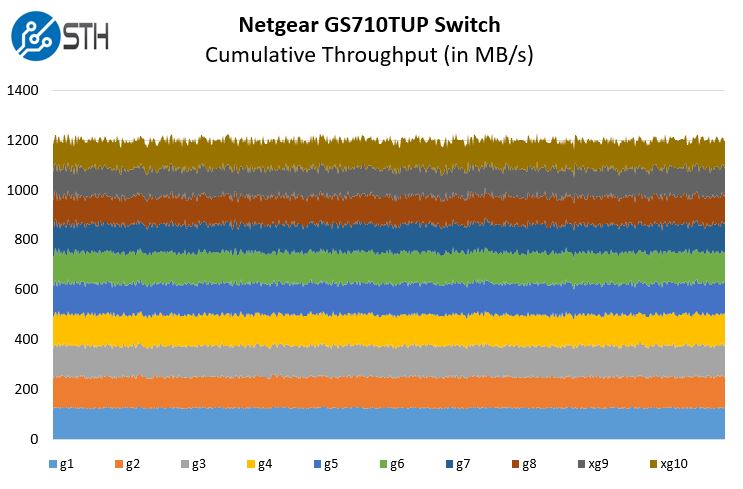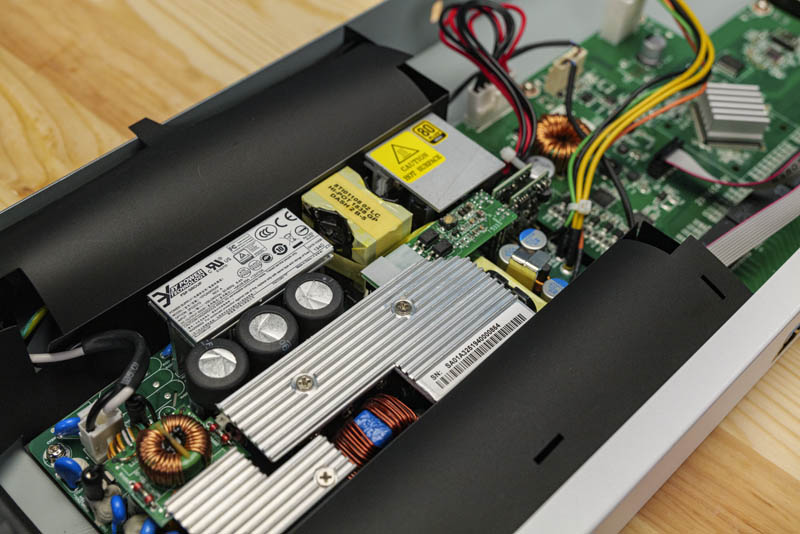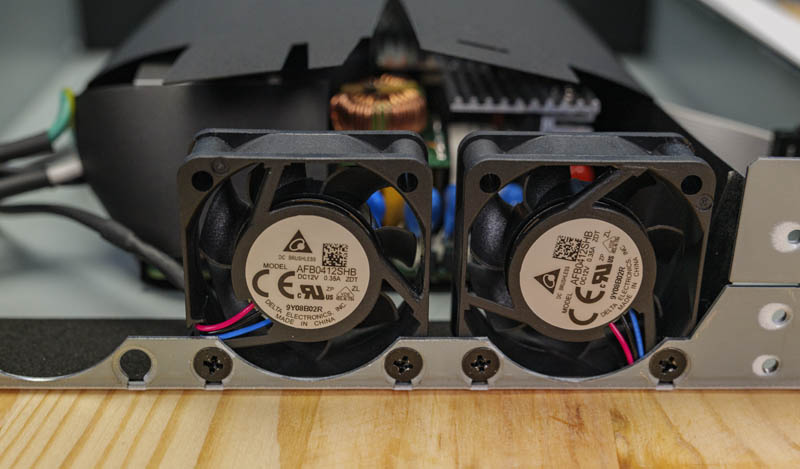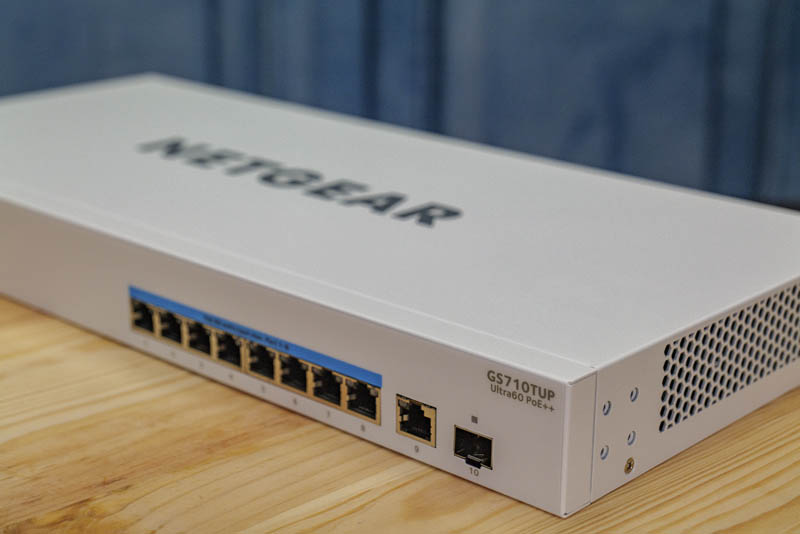Netgear GS710TUP Performance
The Netgear GS710TUP on one hand has a leading feature in PoE++ Type-3 support. On the other hand, it is still a 10x 1GbE switch on the data side. As a result, we get performance around where we would expect:

For some context, we basically have a switch designed to handle traffic of a single 10GbE port. We wish this switch had a 10GbE (SFP+) uplink instead of the SFP and RJ45 uplinks. We also wish this was a multi-gig solution such as a 2.5GbE solution instead of a 1Gbps solution. If you wanted to power a WiFi 6 AP or future private 5G solution with a powered antenna or something, then you would want a greater than 1Gbps link to your network and greater than two 1Gbps uplinks.
This is a case where performance is as advertised, but we somewhat wish Netgear had a more significant focus on performance leadership. Some of this switches competitors when it is priced in the $499 range will start to have more networking performance.
Netgear GS710TUP Power Consumption and Noise
This is one of those areas where the power consumption of the switch itself is going to be dwarfed by devices that are plugged in. With a total of 480W of power that can be delivered over the ports, the power consumption of the switch itself is relatively small. We saw average idle power consumption of around 19W-22W depending on the number of ports plugged in for data-only. 19W was with a single uplink port. Given the 600W power supply and 480W for the PoE++ ports, this means we have headroom in the platform. Netgear probably could have made the port 9 uplink port PoE++ as well given this headroom.

In terms of noise, it is not a loud switch, but it is too loud to have in an office environment. It is probably near silent in the average equipment closet, but even sitting 3 meters away when the switch is idle (after boot and before any cables are plugged in) it is well beyond comfortable. The marketing materials describe “The GS710TUP is rack-mountable,
and with an operating noise of less than 35dBA” (see the datasheet.)

In our ~24.0dba ambient environment, we were seeing over 40dba at a 1m distance with only the power input plugged in and no network ports on our Extech sound meter. We tried a single management uplink port and the noise level did not change. Since the fans, per the management interface, were only running at 25% we see this as a lower limit. We could not replicate Netgear’s numbers in our own setting, albeit we do not have an anechoic chamber. At the same time, our environment has sound deadening that is not present in a typical office setting.
Final Words
Overall, the GS710TUP is what was advertised. It is a ten port 1GbE switch with L2/L3 management capabilities. PoE is the standout feature and what turns what may otherwise be a $75 10-port 1GbE switch into a $415-499 switch. At the time of this writing, there are simply not that many PoE++ switches on the market. Ubiquiti’s offerings typically sell for a bit more. One of the more intriguing alternatives is actually the Netgear GS110TUP. That unit has only 240W capacity downgrading four PoE++ ports to PoE++ ports and assumes lower overall utilization. Still, the GS110TUP is fanless and about $90 less expensive.
The management solution still needs some work. A user logging into the switch that does not want to register the device is left almost without management functionality. Paying $4.99/ year or $9.99/ year for a device is not much, but it starts to add up. Some of our readers will love the Insight Pro solution and gladly pay for it. Others will be completely frustrated by the management options on this switch and the registration requirement for a low-performance switch.

On the noise situation, we leaned on this quite a bit, but for a device that is running at around 20W to push 40dba makes us think we need some fan curve optimization in the firmware. We tried with the original firmware, the newest firmware. We tried with the PSU airflow guide as it came from the factory as well as how we thought it may work better or was intended. Nothing changed the noise and the fact that the airflow guide seemed in a state of disarray compared to the otherwise very substantial solution, seemed a bit odd.
The 480W of PoE++ is a class-leading device at this point and we saw the power supply is more than capable of delivering this level of power. There are not as many PoE++ devices on the market today, and if you want eight ports of PoE++ this is likely the least expensive way to get that. The uninterrupted PoE feature is awesome for many who have devices that cannot power off. We have a very cool project showing what can be done with the higher-levels of power delivery coming soon to STH and are going to show that feature.
At the end of the day, the Netgear GS710TUP delivers what it says it will, and at a relatively good value. One needs to read exactly what they are expecting to get, but if that is done then this will be a solid option. With features such as a lifetime warranty, there are a lot of folks that will simply see this as a way to add a lot of power over an Ethernet cable, tuck it away, and never think about it again. For those folks, this can be a great solution.




I do not understand these artificial limitations.
Why do I have to register a stupid switch this way to gain complete control over a purchased device?
LOL. Before we had switches from Cisco & other US companys, and likely other countries like China with backdoors who were silently implemented (https://en.wikipedia.org/wiki/Cisco_Systems#Firewall_backdoor_developed_by_NSA).
Now we are on the way to be forced into proprietary cloud access, giving away control and opening up a can of worms of major security implications. With or without backdoors manated by national security letters.
Open up your network and its security to Netgears cloud and even their crappy App… What can go wrong?
What a clever idea, at least for Netgear and the hunger for mass surveillance and potential control by the national security establishment.
/s
Sadly this seems to be the way the market leaders are headed. The potential gains for companys like Netgear are too tempting IMO.
Why did you rate the GS710TUP so highly in the score card. In the article, you indicate the value is not good, but you rated 9.2 on the score card. You indicate most users would not be happy paying the annual subscription. You mention that the license agreement to use the full management is not very friendly to the customer as it is has advertising and app data sharing. You mention that it only has mediocre performance.
Granting such a high overall score, you are encouraging netgear to continue with mediocre performance and licensing terms.
@Vicent 100% spot-on. I’ve commented similarly on another product review page, the scores don’t reflect reality, what I’ve seen is mediocre products given unwarranted scores..
Too bad it doesn’t have at least one 10G uplink. Also I’m curious about how long it will take before we get 2.5G as standard. Chipsets have been available since 2013, but the demand has simply not been there. I guess it is only this year that there is enough momentum thanks to 2.5G being common on the latest AMD B550/X570 and Intel B460/Z490 based motherboards. Does anybody know what is a normal timeframe from product development to time-to-market for switches? Can we expect a lot more 2.5G switches next year?
Really? I have to install a smartphone app to enable features on the switch?
Otherwise i only have a “trial version” of a switch, you say? Oh, what a bright and “smart” future lies ahead of us.
I never desired to turn into a grumpy old curmudgeon, but i have to admit finding myself rather liking to live in the past (technology-wise) than to deal with modern craptastic devices like this.
Yeah, and the score. What Vince said, very well put. It sorta gives me the vibes of those videogame magazines of yore (particularly the ones from the UK) with their inflated scores. But then again, i am not enthusiastic about smartphones and smartwatches, and generally am a grumpy curmudgeon who found himself preferring the simpler, less exploitative past (technology-wise), so i guess i am not really hip enough to judge the niner-score-deserving allure of this modern PoE network switch…
So after buying a few Netgear switches (1G+10G, a few PoE+) earlier this year and only recently installing them.. I discover this cloud BS. Seriously? If I update the firmware the switch management will be cloud only. I’m on the last firmware that has “local” login.
The thing is.. and I cannot stress this enough: GTFO!
I’m currently looking for a new network hardware vendor.
Which is a shame because Netgear were good.
I think the score is way off. There is no technical reason to limit the feature set, so this is obviously a strong anti-customer move to force registration and even use of their cloud service. Do they at least assume full liability should their cloud be breached?
@Nils
A related question: Do pigs fly? ;-)
I now have a Netgear switch that required this registration BS. My switch had the option of “local management” or “cloud management”. Of course I chose “local management” as I block all of my switches from outbound access to the Internet; I have internal NTP servers and manage everything on-site. What?! No phone apps to control anything. I know, how lame is that, but it’s fairly secure compared to “phone apps” and “cloud based” BS.
I had to jump through hoops to register the switch as there is a non-inuitive process to obtain the registration key by email for switches that cannot access the Internet. I don’t know the feature set different between “local management” and “cloud management”, but I agree with the article’s observation that the unregistered feature set is practically worthless. I was able to confirm through an arduous email exchange with Netgear Support (they must hire uneducated id10ts to work there) that the registration key is “lifetime”…or until you replace the switch with a Netgear replacement when the first one fails :))
fyi – Once you have registered your Netgear switch, take some time to carefully watch it’s network operation with a packet sniffer. As I said, I block all of my switches from accessing the Internet; that’s how I caught my newly registered switch trying to reach out to the Internet, specifically 2 different AWS locations in the EU are requested on a repetitive basis. Humm… what’s up with that? Will anyone from Netgear tell us since their own Support staff know how to “not answer” (personal experience here) requests for information.
My own impressions of Netgear are positive and built on 10+ years of using their products. never so much as a need to contact support or replace one of their “lifetime warranty” Prosafe switches. And now this registration BS. I guess Netgear isn’t making enough money from their actual products so now they are trying to get us to buy their faux (i.e. “cloud”) products as a way to supplement their revenue stream. Sadly, more and more network equipment vendors with reasonable (or better) quality products are moving in this direction. Let’s face it folks, it’s that “gotta be in the cloud to be cool” attitude that so pervasive in today’s world which is ruining it for the rest of us.
The review itself was pretty fair.
The score is not appropriate however and I would recommend removing or revisiting it. I really like the quality of your site (and have made purchases based off of reviews) and this score undermines all of that.
1) build quality leaves a lot to be desired.
2) lack of >1GbE is a no go if you are using this to power multiple 802.11ac APs. Why am I going to waste a lot of expensive PoE ports on LAGs?
3) select hiding of such basic features behind a paywall without being upfront about it like meraki is not cool. They are trying to copy the model enterprise model using a consumer pricing and retail privacy approach (lol at that privacy policy) which just comes off as disingenuous and cheap. Meraki (et al) are straight forward about all of nothing cloud-management but this is just straight up paywalling for are configured on-device.
A month ago I was weighing various vendors for a new access switch for one of my labs and stuff like this disqualified netgear.
please review the GSM4210P
also MS510TXUP